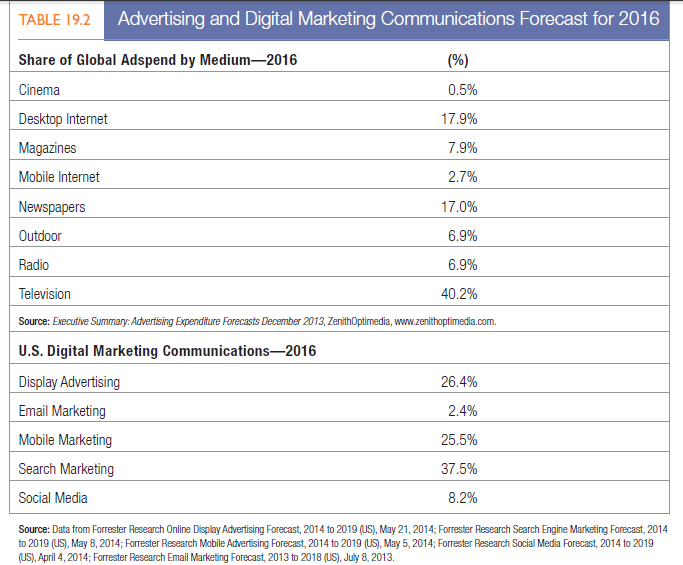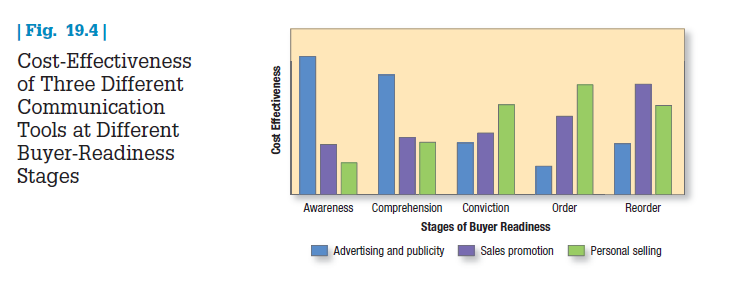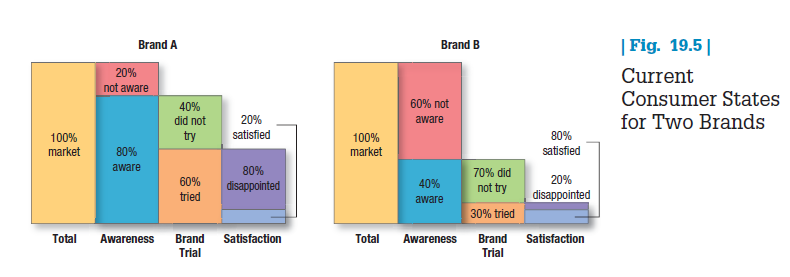Companies must allocate their marketing communications budget over the eight major modes of communication— advertising, sales promotion, events and experiences, public relations and publicity, online and social media marketing, mobile marketing, direct and database marketing, and the sales force. Within the same industry, companies can differ considerably in their media and channel choices. Avon concentrates its promotional funds on personal selling, whereas Revlon spends heavily on advertising. Electrolux spent heavily on a door-to-door sales force for years, whereas Hoover relied more on advertising. Table 19.2 forecasts spending on some major forms of communication.

Companies are always searching for ways to gain efficiency by substituting one communications tool for others. Many are replacing some field sales activity with ads, direct mail, and telemarketing. One auto dealer dismissed his five salespeople and cut prices, and sales exploded. Substitutability among communications tools explains why marketing functions need to be coordinated.
1. CHARACTERISTICS OF THE MARKETING COMMUNICATIONS MIX
Each communication tool has its own unique characteristics and costs. We briefly review them here and discuss them in more detail in Chapters 20, 21, and 22.
ADVERTISING Advertising reaches geographically dispersed buyers. It can build up a long-term image for a product (Coca-Cola ads) or trigger quick sales (a Macy’s ad for a weekend sale). Certain forms of advertising such as TV can require a large budget, whereas other forms such as newspaper do not. The mere presence of advertising might have an effect on sales: Consumers might believe a heavily advertised brand must offer “good value.”34 Because of the many forms and uses of advertising, it’s risky to make generalizations about it.35 Yet a few observations are worthwhile:
- Pervasiveness—Advertising permits the seller to repeat a message many times. It also allows the buyer to receive and compare the messages of various competitors. Large-scale advertising says something positive about the seller’s size, power, and success.
- Amplified expressiveness—Advertising provides opportunities for dramatizing the company and its brands and products through the artful use of print, sound, and color.
- Control—The advertiser can choose the aspects of the brand and product on which to focus communications.
SALES PROMOTION Companies use sales promotion tools—coupons, contests, premiums, and the like—to draw a stronger and quicker buyer response, including short-run effects such as highlighting product offers and boosting sagging sales. Sales promotion tools offer three distinctive benefits:
- Ability to be attention-getting—They draw attention and may lead the consumer to the product.
- Incentive—They incorporate some concession, inducement, or contribution that gives value to the consumer.
- Invitation—They include a distinct invitation to engage in the transaction now.
EVENTS AND EXPERIENCES Events and experiences offer many advantages as long as they have the following characteristics:
- Relevant—A well-chosen event or experience can be seen as highly relevant because the consumer is often personally invested in the outcome.
- Engaging—Given their live, real-time quality, events and experiences are more actively engaging for consumers.
- Implicit—Events are typically an indirect soft sell.
PUBLIC RELATiONS AND PUBLICITY Marketers tend to underuse public relations, yet a well-thought- out program coordinated with the other communications-mix elements can be extremely effective, especially if a company needs to challenge consumers’ misconceptions. The appeal of public relations and publicity is based on three distinctive qualities:
- High credibility—News stories and features are more authentic and credible to readers than ads.
- Ability to reach hard-to-find buyers—Public relations can reach prospects who prefer to avoid mass media and targeted promotions.
- Dramatization—Public relations can tell the story behind a company, brand, or product.
ONLINE AND SOCiAL MEDIA MARKETING Online marketing and messages can take many forms to interact with consumers when they are in active search mode or just browsing and surfing online for something to do. They share three characteristics:
- Rich—Much information or entertainment can be provided—as much or as little as a consumer might want.
- Interactive—Information can be changed or updated depending on the person’s response.
- Up to date—A message can be prepared very quickly and diffused through social media channels.
MOBILE MARKETING Increasingly, online marketing and social media rely on mobile forms of communication and smart phones or tablets. Three distinguishing characteristics of mobile marketing are:
- Timely—Mobile communications can be very time-sensitive and reflect when and where a consumer is.
- Influential—Information received or obtained via a smart phone can reach and influence consumers as they are making a purchase decision.
- Pervasive—Consumers typically carry their smart phones everywhere, so mobile communications are at their fingertips.
DIRECT AND DATABASE MARKETING The advent of “Big Data” has given marketers the opportunity to learn even more about consumers and develop more personal and relevant marketing communications. Three noteworthy characteristics of direct and database marketing are:
- Personal—Personal facts, opinions, and experiences can be stored in massive databases and incorporated into personal messages.
- Proactive—A direct marketing piece can create attention, inform consumers, and include a call to action.
- Complementary—Product information can be provided that helps other marketing communications, especially in terms of e-commerce. A good catalog might spur online shopping.
PERSONAL SELLING Personal selling is the most effective tool at later stages of the buying process, particularly in building up buyer preference, conviction, and action. It has three notable qualities:
- Customized—The message can be designed to appeal to any individual.
- Relationship-oriented—Personal selling relationships can range from a matter-of-fact selling relationship to a deep personal friendship.
- Response-oriented—The buyer is often given personal choices and encouraged to directly respond.
2. FACTORS IN SETTING THE MARKETING COMMUNICATIONS MIX
Companies must consider several factors in developing their communications mix: type of product market, consumer readiness to make a purchase, and stage in the product life cycle.
TYPE OF PRODUCT MARKET Consumer marketers tend to spend comparatively more on sales promotion and advertising; business marketers tend to spend comparatively more on personal selling. In general, personal selling is used more with complex, expensive, and risky goods and in markets with fewer and larger sellers (hence, business markets).
Although marketers rely more on sales calls in business markets, advertising still plays a significant role:
- Advertising can provide an introduction to the company and its products.
- If the product has new features, advertising can explain them.
- Reminder advertising is more economical than sales calls.
- Advertisements offering brochures and carrying the company’s phone number or Web address are an effective way to generate leads for sales representatives.
- Sales representatives can use copies of the company’s ads to legitimize their company and products.
- Advertising can remind customers how to use the product and reassure them about their purchase.
Advertising combined with personal selling can increase sales over personal selling alone. Corporate advertising can improve a company’s reputation and improve the sales force’s chances of getting a favorable first hearing and early adoption of the product. IBM’s recent corporate marketing effort is a notable success.36
IBM SMARTER PLANET Working with long-time ad agency Ogilvy & Mather, IBM launched “Smarter Planet” in 2008 as a business strategy and multiplatform communications program to promote the way in which IBM technology and expertise help government as well as transportation, energy, education, health care, and other businesses work better and “smarter.” The point was that technology has evolved so far that many of the world’s problems are now fixable. The campaign began internally to inform and inspire IBM employees about how they could contribute to building a “Smarter Planet.” It was then rolled out with unconventional long-form, content-rich print ads, targeted TV ads, and detailed online interactive ads. A “Smarter Cities” tour hosted major events at which IBM and other experts discussed and debated challenges all cities face: transportation, energy, health care, education, and public safety. The success of the campaign was evident in the significant improvements in IBM’s image as a company that was “making the world better” and “known for solving its clients’ most challenging problems.” Despite a recession, significant increases occurred in new business opportunities and the number of companies interested in doing business with IBM, and the company’s stock price soared from $80 at the start of the campaign to more than $200 five years later.
On the flip side, personal selling can also make a strong contribution in consumer-goods marketing. Some consumer marketers use the sales force mainly to collect weekly orders from dealers and to see that sufficient stock is on the shelf. Yet an effectively trained company sales force can make four important contributions:
- Increase stock position—Sales reps can persuade dealers to take more stock and devote more shelf space to the company’s brand.
- Build enthusiasm—Sales reps can build dealer enthusiasm by dramatizing planned advertising and communications support for the company’s brand.
- Conduct missionary selling—Sales reps can sign up more dealers.
- Manage key accounts—Sales reps can take responsibility for growing business with the most important accounts.
BUYER-READINESS STAGE Communication tools vary in cost-effectiveness at different stages of buyer readiness. Figure 19.4 shows the relative cost-effectiveness of three communication tools. Advertising and publicity play the most important roles in the awareness-building stage. Customer comprehension is primarily affected by advertising and personal selling. Customer conviction is influenced mostly by personal selling. Personal selling and sales promotion are most helpful in closing the sale. Reordering is also affected mostly by personal selling and sales promotion and somewhat by reminder advertising. Note too that online activities can affect virtually any stage.


PRODUCT LIFE-CYCLE STAGE In the introduction stage of the product life cycle, advertising, events and experiences, and publicity have the highest cost-effectiveness, followed by personal selling to gain distribution coverage and sales promotion and direct marketing to induce trial. In the growth stage, demand has its own momentum through word of mouth and interactive marketing. Advertising, events and experiences, and personal selling all become more important in the maturity stage. In the decline stage, sales promotion continues strong, other communication tools are reduced, and salespeople give the product only minimal attention.
2. MEASURING COMMUNICATION RESULTS
Senior managers want to know the outcomes and revenues resulting from their communications investments. Too often, however, their communications directors supply only inputs and expenses: press clipping counts, numbers of ads placed, or media costs. In fairness, communications directors try to translate inputs into intermediate outputs such as reach and frequency (the percentage of target market exposed to a communication and the number of exposures), recall and recognition scores, persuasion changes, and cost-per-thousand calculations. Ultimately, though, behavior-change measures capture the real payoff.
After implementing the communications plan, the communications director must measure its impact. Members of the target audience are asked whether they recognize or recall the message, how many times they saw it, what points they recall, how they felt about the message, and what are their previous and current attitudes toward the product and the company. The communicator should also collect behavioral measures of audience response, such as how many people bought the product, liked it, and talked to others about it.
Figure 19.5 provides an example of good feedback measurement. We find 80 percent of the consumers in the total market are aware of brand A, 60 percent have tried it, and only 20 percent who tried it are satisfied. This indicates that the communications program is effective in creating awareness, but the product fails to meet consumer expectations. In contrast, 40 percent of the consumers in the total market are aware of brand B and only 30 percent have tried it, but 80 percent of them are satisfied. In this case, the communications program needs to be strengthened to take advantage of the brand’s potential power.
Source: Kotler Philip T., Keller Kevin Lane (2015), Marketing Management, Pearson; 15th Edition.

Wow that was unusual. I just wrote an very long comment but after I clicked submit my comment didn’t appear. Grrrr… well I’m not writing all that over again. Anyway, just wanted to say wonderful blog!